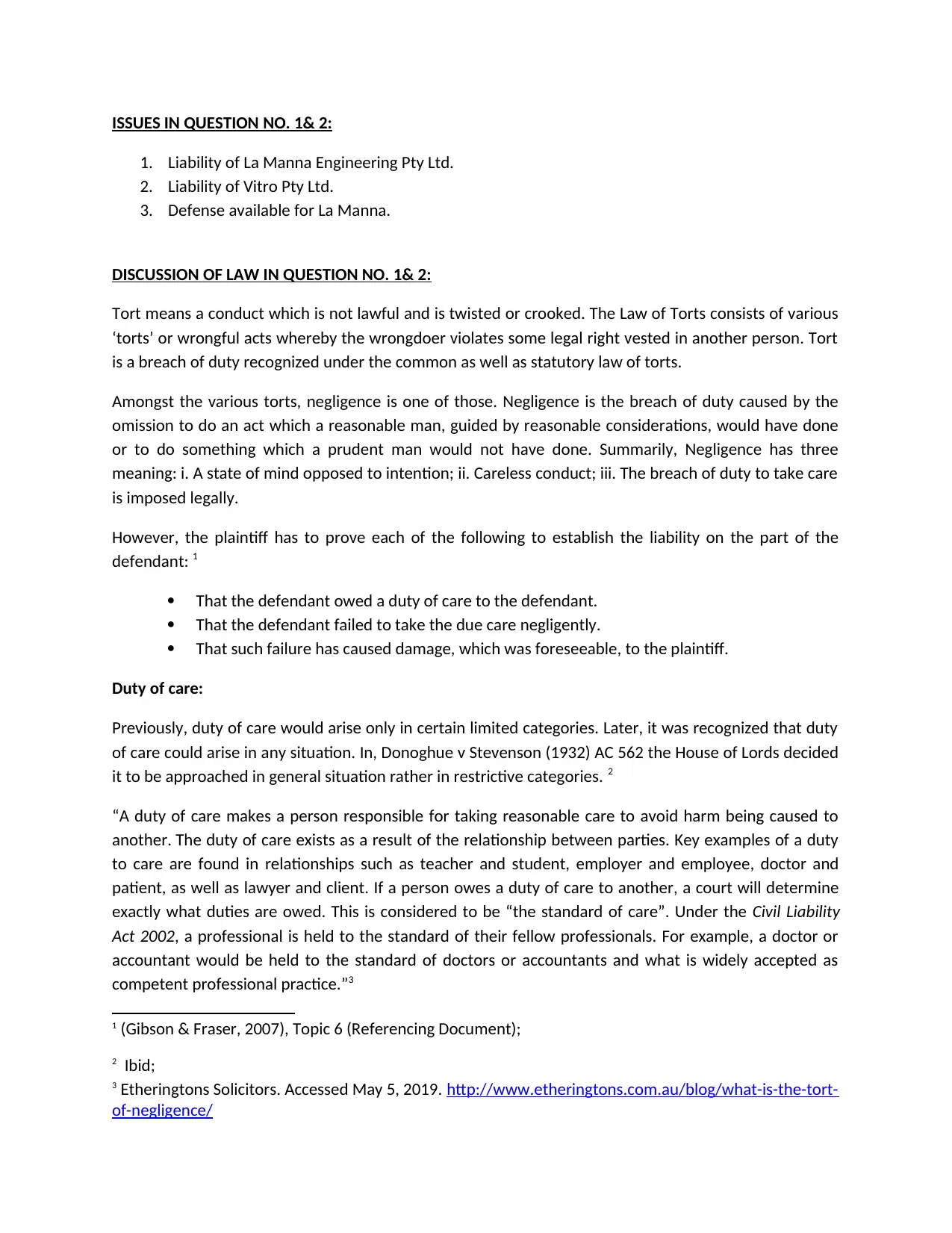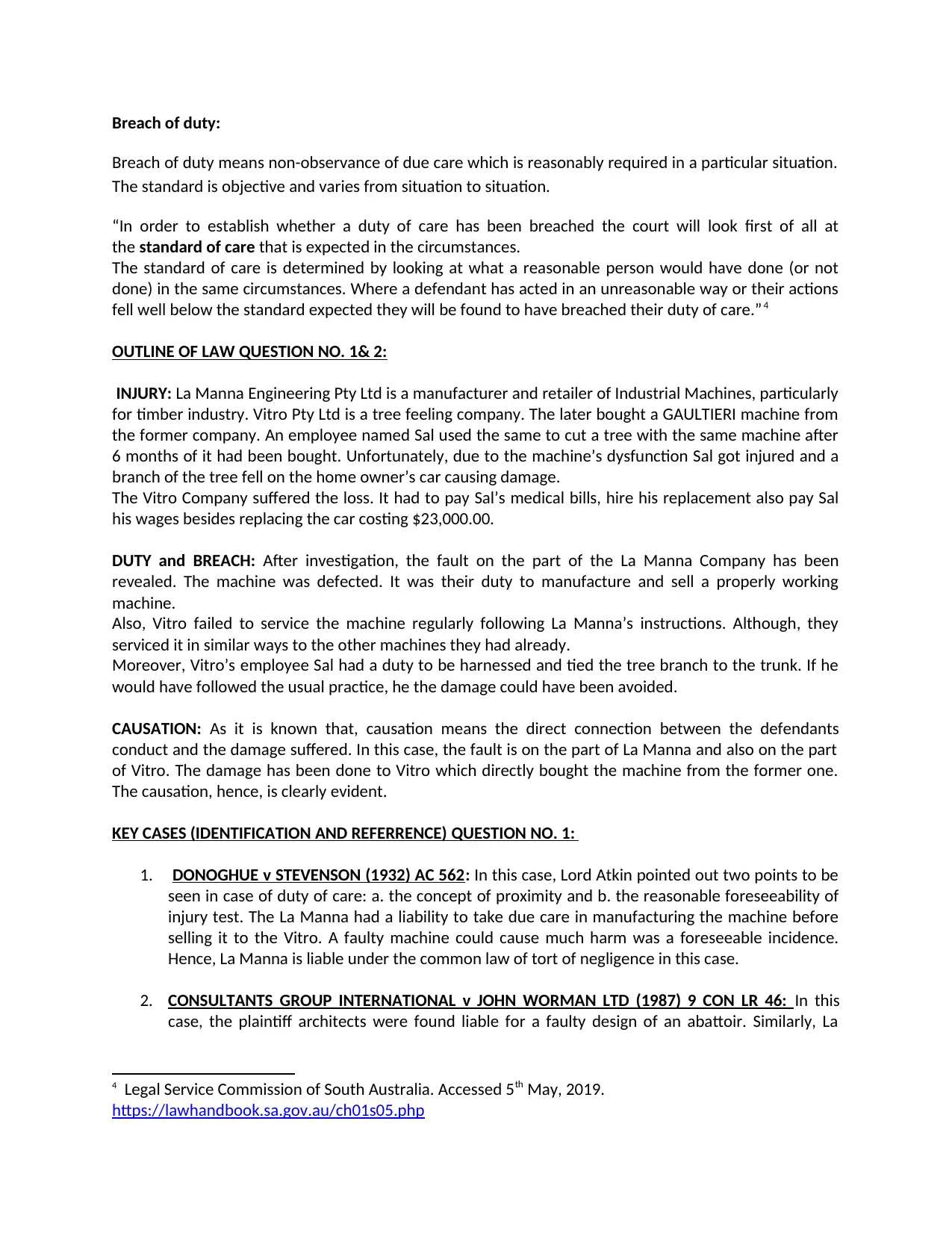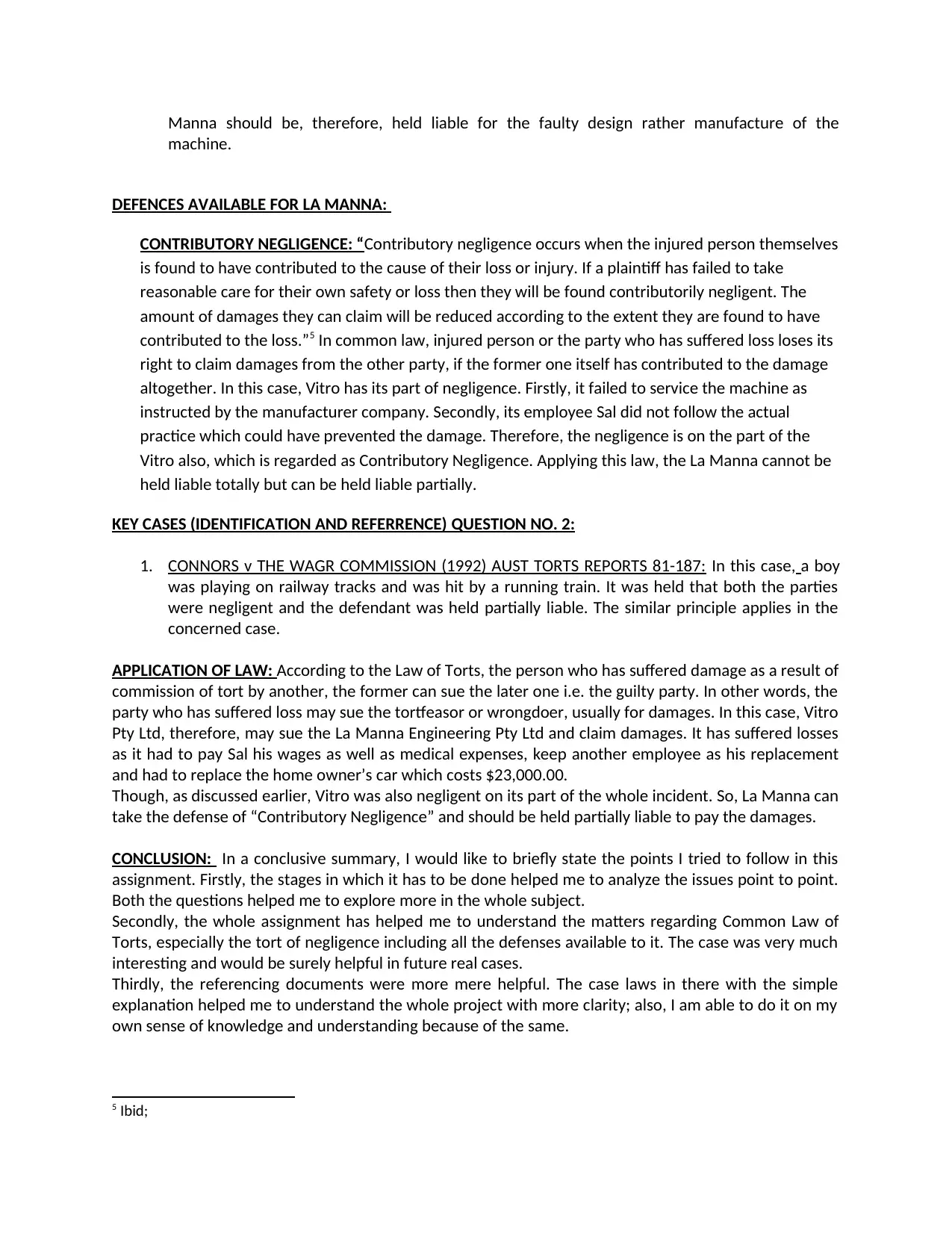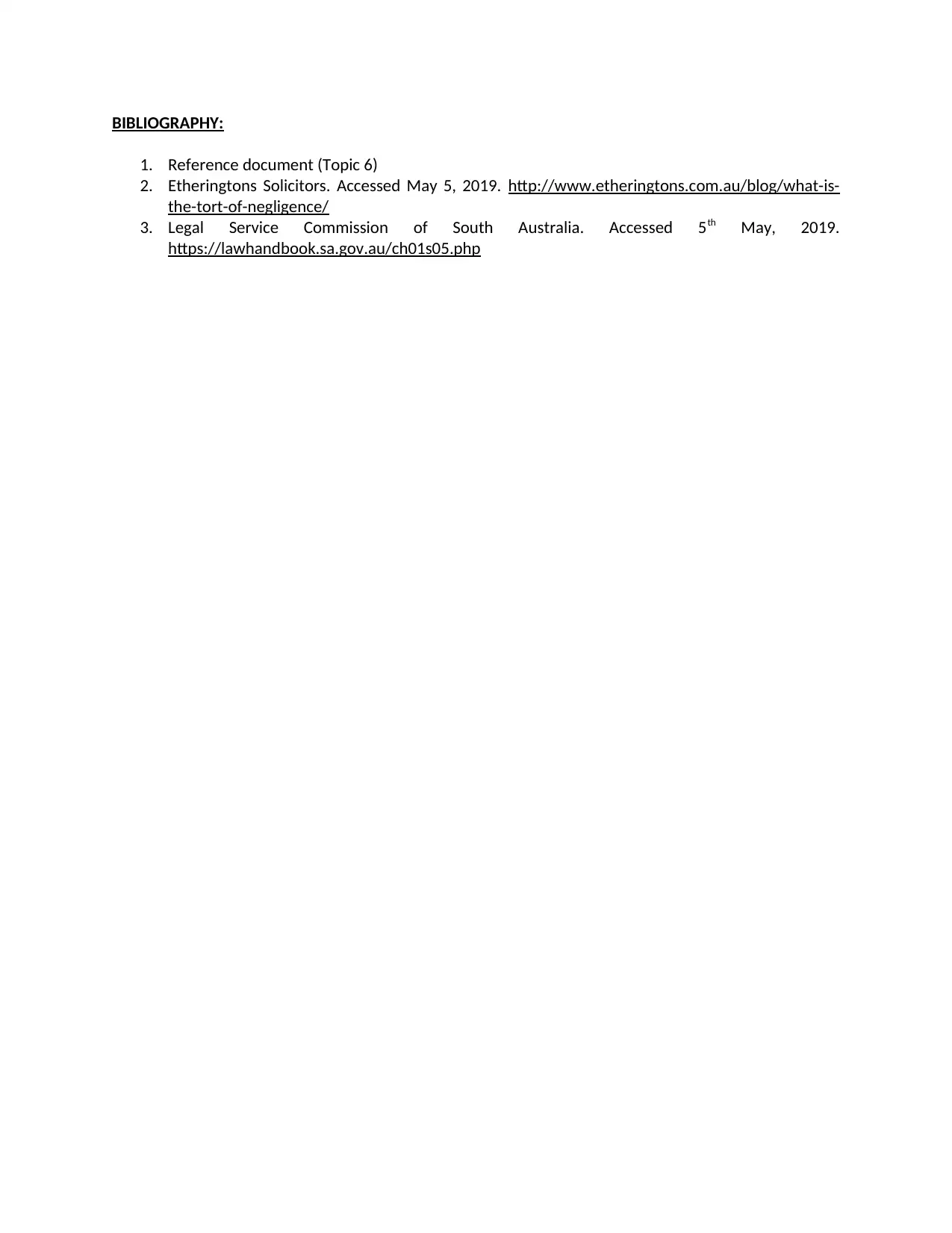Curtin University Law for Engineers Assignment 2: Negligence
VerifiedAdded on 2023/01/18
|4
|1741
|67
Homework Assignment
AI Summary
This assignment solution addresses a law problem concerning negligence, specifically focusing on the liability of La Manna Engineering Pty Ltd and Vitro Pty Ltd. It delves into the elements of negligence, including duty of care, breach of duty, and causation, supported by relevant case law such as Donoghue v Stevenson. The solution analyzes the scenario where a machine defect caused injury and property damage, assessing the responsibilities of both the manufacturer and the user. It explores defenses like contributory negligence, citing cases like Connors v The Wagr Commission, and applies the law of torts to determine potential damages. The document concludes with a summary of the key points and a bibliography of the referenced materials.

ISSUES IN QUESTION NO. 1& 2:
1. Liability of La Manna Engineering Pty Ltd.
2. Liability of Vitro Pty Ltd.
3. Defense available for La Manna.
DISCUSSION OF LAW IN QUESTION NO. 1& 2:
Tort means a conduct which is not lawful and is twisted or crooked. The Law of Torts consists of various
‘torts’ or wrongful acts whereby the wrongdoer violates some legal right vested in another person. Tort
is a breach of duty recognized under the common as well as statutory law of torts.
Amongst the various torts, negligence is one of those. Negligence is the breach of duty caused by the
omission to do an act which a reasonable man, guided by reasonable considerations, would have done
or to do something which a prudent man would not have done. Summarily, Negligence has three
meaning: i. A state of mind opposed to intention; ii. Careless conduct; iii. The breach of duty to take care
is imposed legally.
However, the plaintiff has to prove each of the following to establish the liability on the part of the
defendant: 1
That the defendant owed a duty of care to the defendant.
That the defendant failed to take the due care negligently.
That such failure has caused damage, which was foreseeable, to the plaintiff.
Duty of care:
Previously, duty of care would arise only in certain limited categories. Later, it was recognized that duty
of care could arise in any situation. In, Donoghue v Stevenson (1932) AC 562 the House of Lords decided
it to be approached in general situation rather in restrictive categories. 2
“A duty of care makes a person responsible for taking reasonable care to avoid harm being caused to
another. The duty of care exists as a result of the relationship between parties. Key examples of a duty
to care are found in relationships such as teacher and student, employer and employee, doctor and
patient, as well as lawyer and client. If a person owes a duty of care to another, a court will determine
exactly what duties are owed. This is considered to be “the standard of care”. Under the Civil Liability
Act 2002, a professional is held to the standard of their fellow professionals. For example, a doctor or
accountant would be held to the standard of doctors or accountants and what is widely accepted as
competent professional practice.”3
1 (Gibson & Fraser, 2007), Topic 6 (Referencing Document);
2 Ibid;
3 Etheringtons Solicitors. Accessed May 5, 2019. http://www.etheringtons.com.au/blog/what-is-the-tort-
of-negligence/
1. Liability of La Manna Engineering Pty Ltd.
2. Liability of Vitro Pty Ltd.
3. Defense available for La Manna.
DISCUSSION OF LAW IN QUESTION NO. 1& 2:
Tort means a conduct which is not lawful and is twisted or crooked. The Law of Torts consists of various
‘torts’ or wrongful acts whereby the wrongdoer violates some legal right vested in another person. Tort
is a breach of duty recognized under the common as well as statutory law of torts.
Amongst the various torts, negligence is one of those. Negligence is the breach of duty caused by the
omission to do an act which a reasonable man, guided by reasonable considerations, would have done
or to do something which a prudent man would not have done. Summarily, Negligence has three
meaning: i. A state of mind opposed to intention; ii. Careless conduct; iii. The breach of duty to take care
is imposed legally.
However, the plaintiff has to prove each of the following to establish the liability on the part of the
defendant: 1
That the defendant owed a duty of care to the defendant.
That the defendant failed to take the due care negligently.
That such failure has caused damage, which was foreseeable, to the plaintiff.
Duty of care:
Previously, duty of care would arise only in certain limited categories. Later, it was recognized that duty
of care could arise in any situation. In, Donoghue v Stevenson (1932) AC 562 the House of Lords decided
it to be approached in general situation rather in restrictive categories. 2
“A duty of care makes a person responsible for taking reasonable care to avoid harm being caused to
another. The duty of care exists as a result of the relationship between parties. Key examples of a duty
to care are found in relationships such as teacher and student, employer and employee, doctor and
patient, as well as lawyer and client. If a person owes a duty of care to another, a court will determine
exactly what duties are owed. This is considered to be “the standard of care”. Under the Civil Liability
Act 2002, a professional is held to the standard of their fellow professionals. For example, a doctor or
accountant would be held to the standard of doctors or accountants and what is widely accepted as
competent professional practice.”3
1 (Gibson & Fraser, 2007), Topic 6 (Referencing Document);
2 Ibid;
3 Etheringtons Solicitors. Accessed May 5, 2019. http://www.etheringtons.com.au/blog/what-is-the-tort-
of-negligence/
Paraphrase This Document
Need a fresh take? Get an instant paraphrase of this document with our AI Paraphraser

Breach of duty:
Breach of duty means non-observance of due care which is reasonably required in a particular situation.
The standard is objective and varies from situation to situation.
“In order to establish whether a duty of care has been breached the court will look first of all at
the standard of care that is expected in the circumstances.
The standard of care is determined by looking at what a reasonable person would have done (or not
done) in the same circumstances. Where a defendant has acted in an unreasonable way or their actions
fell well below the standard expected they will be found to have breached their duty of care.”4
OUTLINE OF LAW QUESTION NO. 1& 2:
INJURY: La Manna Engineering Pty Ltd is a manufacturer and retailer of Industrial Machines, particularly
for timber industry. Vitro Pty Ltd is a tree feeling company. The later bought a GAULTIERI machine from
the former company. An employee named Sal used the same to cut a tree with the same machine after
6 months of it had been bought. Unfortunately, due to the machine’s dysfunction Sal got injured and a
branch of the tree fell on the home owner’s car causing damage.
The Vitro Company suffered the loss. It had to pay Sal’s medical bills, hire his replacement also pay Sal
his wages besides replacing the car costing $23,000.00.
DUTY and BREACH: After investigation, the fault on the part of the La Manna Company has been
revealed. The machine was defected. It was their duty to manufacture and sell a properly working
machine.
Also, Vitro failed to service the machine regularly following La Manna’s instructions. Although, they
serviced it in similar ways to the other machines they had already.
Moreover, Vitro’s employee Sal had a duty to be harnessed and tied the tree branch to the trunk. If he
would have followed the usual practice, he the damage could have been avoided.
CAUSATION: As it is known that, causation means the direct connection between the defendants
conduct and the damage suffered. In this case, the fault is on the part of La Manna and also on the part
of Vitro. The damage has been done to Vitro which directly bought the machine from the former one.
The causation, hence, is clearly evident.
KEY CASES (IDENTIFICATION AND REFERRENCE) QUESTION NO. 1:
1. DONOGHUE v STEVENSON (1932) AC 562: In this case, Lord Atkin pointed out two points to be
seen in case of duty of care: a. the concept of proximity and b. the reasonable foreseeability of
injury test. The La Manna had a liability to take due care in manufacturing the machine before
selling it to the Vitro. A faulty machine could cause much harm was a foreseeable incidence.
Hence, La Manna is liable under the common law of tort of negligence in this case.
2. CONSULTANTS GROUP INTERNATIONAL v JOHN WORMAN LTD (1987) 9 CON LR 46: In this
case, the plaintiff architects were found liable for a faulty design of an abattoir. Similarly, La
4 Legal Service Commission of South Australia. Accessed 5th May, 2019.
https://lawhandbook.sa.gov.au/ch01s05.php
Breach of duty means non-observance of due care which is reasonably required in a particular situation.
The standard is objective and varies from situation to situation.
“In order to establish whether a duty of care has been breached the court will look first of all at
the standard of care that is expected in the circumstances.
The standard of care is determined by looking at what a reasonable person would have done (or not
done) in the same circumstances. Where a defendant has acted in an unreasonable way or their actions
fell well below the standard expected they will be found to have breached their duty of care.”4
OUTLINE OF LAW QUESTION NO. 1& 2:
INJURY: La Manna Engineering Pty Ltd is a manufacturer and retailer of Industrial Machines, particularly
for timber industry. Vitro Pty Ltd is a tree feeling company. The later bought a GAULTIERI machine from
the former company. An employee named Sal used the same to cut a tree with the same machine after
6 months of it had been bought. Unfortunately, due to the machine’s dysfunction Sal got injured and a
branch of the tree fell on the home owner’s car causing damage.
The Vitro Company suffered the loss. It had to pay Sal’s medical bills, hire his replacement also pay Sal
his wages besides replacing the car costing $23,000.00.
DUTY and BREACH: After investigation, the fault on the part of the La Manna Company has been
revealed. The machine was defected. It was their duty to manufacture and sell a properly working
machine.
Also, Vitro failed to service the machine regularly following La Manna’s instructions. Although, they
serviced it in similar ways to the other machines they had already.
Moreover, Vitro’s employee Sal had a duty to be harnessed and tied the tree branch to the trunk. If he
would have followed the usual practice, he the damage could have been avoided.
CAUSATION: As it is known that, causation means the direct connection between the defendants
conduct and the damage suffered. In this case, the fault is on the part of La Manna and also on the part
of Vitro. The damage has been done to Vitro which directly bought the machine from the former one.
The causation, hence, is clearly evident.
KEY CASES (IDENTIFICATION AND REFERRENCE) QUESTION NO. 1:
1. DONOGHUE v STEVENSON (1932) AC 562: In this case, Lord Atkin pointed out two points to be
seen in case of duty of care: a. the concept of proximity and b. the reasonable foreseeability of
injury test. The La Manna had a liability to take due care in manufacturing the machine before
selling it to the Vitro. A faulty machine could cause much harm was a foreseeable incidence.
Hence, La Manna is liable under the common law of tort of negligence in this case.
2. CONSULTANTS GROUP INTERNATIONAL v JOHN WORMAN LTD (1987) 9 CON LR 46: In this
case, the plaintiff architects were found liable for a faulty design of an abattoir. Similarly, La
4 Legal Service Commission of South Australia. Accessed 5th May, 2019.
https://lawhandbook.sa.gov.au/ch01s05.php

Manna should be, therefore, held liable for the faulty design rather manufacture of the
machine.
DEFENCES AVAILABLE FOR LA MANNA:
CONTRIBUTORY NEGLIGENCE: “Contributory negligence occurs when the injured person themselves
is found to have contributed to the cause of their loss or injury. If a plaintiff has failed to take
reasonable care for their own safety or loss then they will be found contributorily negligent. The
amount of damages they can claim will be reduced according to the extent they are found to have
contributed to the loss.”5 In common law, injured person or the party who has suffered loss loses its
right to claim damages from the other party, if the former one itself has contributed to the damage
altogether. In this case, Vitro has its part of negligence. Firstly, it failed to service the machine as
instructed by the manufacturer company. Secondly, its employee Sal did not follow the actual
practice which could have prevented the damage. Therefore, the negligence is on the part of the
Vitro also, which is regarded as Contributory Negligence. Applying this law, the La Manna cannot be
held liable totally but can be held liable partially.
KEY CASES (IDENTIFICATION AND REFERRENCE) QUESTION NO. 2:
1. CONNORS v THE WAGR COMMISSION (1992) AUST TORTS REPORTS 81-187: In this case, a boy
was playing on railway tracks and was hit by a running train. It was held that both the parties
were negligent and the defendant was held partially liable. The similar principle applies in the
concerned case.
APPLICATION OF LAW: According to the Law of Torts, the person who has suffered damage as a result of
commission of tort by another, the former can sue the later one i.e. the guilty party. In other words, the
party who has suffered loss may sue the tortfeasor or wrongdoer, usually for damages. In this case, Vitro
Pty Ltd, therefore, may sue the La Manna Engineering Pty Ltd and claim damages. It has suffered losses
as it had to pay Sal his wages as well as medical expenses, keep another employee as his replacement
and had to replace the home owner’s car which costs $23,000.00.
Though, as discussed earlier, Vitro was also negligent on its part of the whole incident. So, La Manna can
take the defense of “Contributory Negligence” and should be held partially liable to pay the damages.
CONCLUSION: In a conclusive summary, I would like to briefly state the points I tried to follow in this
assignment. Firstly, the stages in which it has to be done helped me to analyze the issues point to point.
Both the questions helped me to explore more in the whole subject.
Secondly, the whole assignment has helped me to understand the matters regarding Common Law of
Torts, especially the tort of negligence including all the defenses available to it. The case was very much
interesting and would be surely helpful in future real cases.
Thirdly, the referencing documents were more mere helpful. The case laws in there with the simple
explanation helped me to understand the whole project with more clarity; also, I am able to do it on my
own sense of knowledge and understanding because of the same.
5 Ibid;
machine.
DEFENCES AVAILABLE FOR LA MANNA:
CONTRIBUTORY NEGLIGENCE: “Contributory negligence occurs when the injured person themselves
is found to have contributed to the cause of their loss or injury. If a plaintiff has failed to take
reasonable care for their own safety or loss then they will be found contributorily negligent. The
amount of damages they can claim will be reduced according to the extent they are found to have
contributed to the loss.”5 In common law, injured person or the party who has suffered loss loses its
right to claim damages from the other party, if the former one itself has contributed to the damage
altogether. In this case, Vitro has its part of negligence. Firstly, it failed to service the machine as
instructed by the manufacturer company. Secondly, its employee Sal did not follow the actual
practice which could have prevented the damage. Therefore, the negligence is on the part of the
Vitro also, which is regarded as Contributory Negligence. Applying this law, the La Manna cannot be
held liable totally but can be held liable partially.
KEY CASES (IDENTIFICATION AND REFERRENCE) QUESTION NO. 2:
1. CONNORS v THE WAGR COMMISSION (1992) AUST TORTS REPORTS 81-187: In this case, a boy
was playing on railway tracks and was hit by a running train. It was held that both the parties
were negligent and the defendant was held partially liable. The similar principle applies in the
concerned case.
APPLICATION OF LAW: According to the Law of Torts, the person who has suffered damage as a result of
commission of tort by another, the former can sue the later one i.e. the guilty party. In other words, the
party who has suffered loss may sue the tortfeasor or wrongdoer, usually for damages. In this case, Vitro
Pty Ltd, therefore, may sue the La Manna Engineering Pty Ltd and claim damages. It has suffered losses
as it had to pay Sal his wages as well as medical expenses, keep another employee as his replacement
and had to replace the home owner’s car which costs $23,000.00.
Though, as discussed earlier, Vitro was also negligent on its part of the whole incident. So, La Manna can
take the defense of “Contributory Negligence” and should be held partially liable to pay the damages.
CONCLUSION: In a conclusive summary, I would like to briefly state the points I tried to follow in this
assignment. Firstly, the stages in which it has to be done helped me to analyze the issues point to point.
Both the questions helped me to explore more in the whole subject.
Secondly, the whole assignment has helped me to understand the matters regarding Common Law of
Torts, especially the tort of negligence including all the defenses available to it. The case was very much
interesting and would be surely helpful in future real cases.
Thirdly, the referencing documents were more mere helpful. The case laws in there with the simple
explanation helped me to understand the whole project with more clarity; also, I am able to do it on my
own sense of knowledge and understanding because of the same.
5 Ibid;
⊘ This is a preview!⊘
Do you want full access?
Subscribe today to unlock all pages.

Trusted by 1+ million students worldwide

BIBLIOGRAPHY:
1. Reference document (Topic 6)
2. Etheringtons Solicitors. Accessed May 5, 2019. http://www.etheringtons.com.au/blog/what-is-
the-tort-of-negligence/
3. Legal Service Commission of South Australia. Accessed 5th May, 2019.
https://lawhandbook.sa.gov.au/ch01s05.php
1. Reference document (Topic 6)
2. Etheringtons Solicitors. Accessed May 5, 2019. http://www.etheringtons.com.au/blog/what-is-
the-tort-of-negligence/
3. Legal Service Commission of South Australia. Accessed 5th May, 2019.
https://lawhandbook.sa.gov.au/ch01s05.php
1 out of 4
Related Documents
Your All-in-One AI-Powered Toolkit for Academic Success.
+13062052269
info@desklib.com
Available 24*7 on WhatsApp / Email
![[object Object]](/_next/static/media/star-bottom.7253800d.svg)
Unlock your academic potential
Copyright © 2020–2025 A2Z Services. All Rights Reserved. Developed and managed by ZUCOL.





